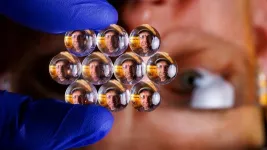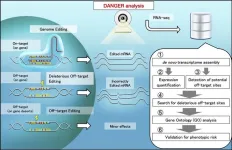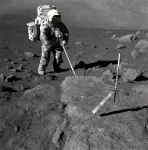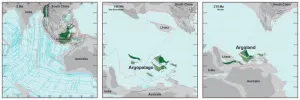(Press-News.org) They number in the thousands, light striking the phalanx of lenses arrayed on a face in geometric pattern, the beams refracting through transparent mounds no wider than a hair.
A fly’s eye boasts roughly 4,000 microscopic lenses, a honeybee’s up to twice that many. These lenses, though, belong not to a compound eye but to polydimethylsiloxane — a flexible polymer long ranking as a favored playground of Nebraska’s Stephen Morin and his band of fellow chemists.
With the aid of engineers Ruiguo Yang and Grayson Minnick, Morin’s team can now arrange and affix tiny gelatinous lenses to an elastic material that accommodates an even grander achievement. By carving the equivalent of aqueducts into the material, then running temperature-altering or water-gathering fluids through those channels, the researchers can also expand or contract the lenses in mere seconds — modifying their magnification, focal length and other optical properties in the process.
Whereas insects and crustaceans evolved their multifaceted eyes to draw in panoramas of ancient environments, Morin’s team is envisioning the future: projecting signals onto sensors embedded in soft robotic skins, for instance, via on-demand control.
“The artificial micro-lenses we have today are relatively static,” said Morin, associate professor of chemistry at the University of Nebraska–Lincoln. “They have a fixed focal length, a fixed size. They are made from materials that give you the lensing property you want, but they don’t really have any dynamic characteristics.”
To add that missing dynamism, Morin and his colleagues turned to hydrogels, the class of water-infused polymers that lend soft contact lenses their pliability. In the past, the team had physically adhered hydrogel islands to silicone materials, a deceptively difficult feat in its own right. But enough agitation, or the introduction of enough water, would inevitably detach the islands from their silicone base.
“The problem is that putting those together in a way that they function synergistically is not well-established,” Morin said. “There wasn’t really anything out there that was putting these two materials together in a robust, long-term platform.”
Overcoming the challenge, Morin knew, would mean supplementing the physical connection with a chemical one. Doctoral student John Kapitan and the team began by priming the transparent silicone with a patterned plasma treatment, coating it with strategic molecular groups and a lithium-based compound, depositing the hydrogel islands, then later applying just the right wavelengths of ultraviolet light. That light initiates the release of highly reactive free radicals that hopscotch across various molecular groups, essentially propagating chains that protrude both up from the silicone itself and across the emerging structure, stabilizing it.
“When it’s all said and done,” Morin said, “you have a somewhat monolithic structure.
“Now, in addition to that physical part, there’s this chemical element. And that was really the secret sauce.”
Morin and his colleagues would “aggressively” put the monolith through its paces. They threw water on it. They stretched the silicone, twisted it. They slapped on pieces of tape and peeled them off, trying to take the lenses with them. They even gave it an ultrasonic bath, peppering it with frequencies often used to clean jewelry, electronics and other grime-attracting products. The microscopic lenses hung tough through it all.
“When we were done, we were pretty satisfied that they were stuck on there pretty well,” Morin said.
Another series of experiments, led by doctoral student Brennan Watts, would soon test and demonstrate the lenses in action. In one, the team shone light on a Nebraska N, projecting it onto an array of hydrogel lenses and, beyond them, a microscope positioned to view the resulting images. When the researchers ran cold water through the material supporting those lenses, the Nebraska N appeared sharp, in focus. Just seconds after cranking that water up to 178 degrees Fahrenheit, the lenses shrank and, on cue, the N blurred out of focus.
To its surprise, the team would later learn that the shift in focus stemmed not from the changing size or curvature of the lenses, but instead mostly from an alteration to their so-called refractive index. Light travels at different speeds when passing through different media — air, water, the human eye — and those changes in speed correspond to the light refracting, or bending, at different angles. As the hydrogel heated up and the lenses contracted, they actually expelled some of their water — upping their density, modifying their refractive index and, ultimately, blurring the image of the N.
While Morin said that on-the-fly adaptability bodes well for the design’s use in micro-projection systems, the chemist is also intrigued by its potential applications in biology. Because hydrogel generally mimics the gelatinous network residing between the cells of complex organisms, researchers often favor it when attempting to culture cells or tissues outside a biological environment.
A device designed by Yang, associate professor of mechanical and materials engineering, has granted Morin’s lab precise control over not just the size, patterning and composition of the hydrogel lenses it deposits, but the orientation and tension of the silicone they reside on, too. That precision, combined with the team’s ability to reversibly manipulate the lenses themselves, might expand the culturing options available to those working in biomaterials and biomedical engineering, Morin said.
“It would seem reasonable that these types of dynamic changes in size and stiffness and things of that nature would have a profound effect on the biology of anything contained in them,” he said. “We’re not there yet, but we certainly have interest in those problems.”
For Morin, who’s spent years experimenting with silicones and other polymers, the practical considerations of adaptable materials are informing, and informed by, the philosophical. There was, he said, a sensible reason for attaching the hydrogel lenses to silicone: Its elasticity relieves some of the stress imposed by the swelling and shrinking of the lenses, helping it maintain a longer-term grip than other, more brittle materials might.
But the chemist is also keen on reconsidering the physical and functional rigidity of what gets made — of viewing materials and structures through a new lens, give or take a few thousand.
“There’s some confusion, I think, as to why we want materials that adapt,” he said. “And I think that’s built into the way that we’ve designed and manufactured materials … going all the way back to whenever we first started making things, I suppose.
“I always make the argument that it would be great if, 100 years from now, the materials we made were able to adapt as we grow and change, as opposed to just being designed to stay the same the whole way through. Of course, this work is just a microcosm of that. But that’s the idea. That’s what adaptive materials could give us.”
The team, which also included Nebraska’s Nengjian Huang and Mark Rose, reported its findings in the journal Advanced Functional Materials. The researchers received support from the Army Research Office and the National Science Foundation.
END
Chemists, engineers craft adjustable arrays of microscopic lenses
Design could find use in soft robotics, liquid optics
2023-10-23
ELSE PRESS RELEASES FROM THIS DATE:
Researchers develop DANGER analysis tool for the safer design of gene editing
2023-10-23
A team of researchers has developed a software tool called DANGER (Deleterious and ANticipatable Guides Evaluated by RNA-sequencing) analysis that provides a way for the safer design of genome editing in all organisms with a transcriptome. For about a decade, researchers have used the CRISPR technology for genome editing. However, there are some challenges in the use of CRISPR. The DANGER analysis overcomes these challenges and allows researchers to perform safer on- and off-target assessments without a reference genome. It holds the potential for applications in medicine, agriculture, and biological research.
Their ...
Lung cancer outcomes significantly improved with immunotherapy-based treatment given before and after surgery
2023-10-23
HOUSTON ― A regimen of pre-surgical immunotherapy and chemotherapy followed by post-surgical immunotherapy significantly improved event-free survival (EFS) and pathologic complete response (pCR) rates compared to chemotherapy alone for patients with operable non-small cell lung cancer (NSCLC), according to results of a Phase III trial reported by researchers at The University of Texas MD Anderson Cancer Center.
The findings, published today in the New England Journal of Medicine, were first presented at the American Association for Cancer Research (AACR) Annual Meeting 2023.
The AEGEAN trial evaluated durvalumab given perioperatively, meaning therapy ...
KICT develops scan to BIM for reverse engineering from 3D vision data
2023-10-23
Korea Institute of Civil Engineering and Building Technology (KICT, President Kim Byung-suk) has developed building scan to BIM (Building Information Modeling)-based reverse engineering technology required for 3D geospatial information modeling domains such as digital twin information modeling.
Scan to BIM-based reverse engineering technology was studied to prevent errors and rework caused by manual work when modeling shapes or BIM from 3D scan data. Existing reverse engineering work is either done based on a lot of manual work or semi-automatically using expensive overseas software.
KICT Research Fellow Dr. Kang Tae-wook ...
Crystals brought back by astronauts show that the Moon is 40 million years older than scientists thought
2023-10-23
More than 4 billion years ago, when the Solar System was still young and the Earth was still growing, a giant object the size of Mars crashed into the Earth. The biggest piece that broke off of the early Earth formed our Moon. But precisely when this happened has remained a mystery. In a new study in the journal Geochemical Perspectives Letters, researchers used crystals brought back from the Moon by Apollo astronauts in 1972 to help pinpoint the time of the Moon’s formation. Their discovery pushes back the age of the Moon by 40 million years, to at least 4.46 billion years old.
“These ...
Probiotics delivered in biofilm state protect the intestines and brain in NEC model
2023-10-23
(COLUMBUS, Ohio) – Necrotizing enterocolitis (NEC) is a debilitating and deadly condition that affects infants who were born preterm. In NEC cases, intestinal tissues become inflamed, and in severe cases there is ischemia and death of the involved intestines. Treatment for NEC often involves surgery to remove the dying tissue.
“Even after decades of research, little has changed in terms of prognosis for infants who develop NEC,” says Gail Besner, MD, pediatric surgeon and principal investigator in the Center for Perinatal Research at Nationwide Children’s. ...
Heated yoga may reduce depression symptoms, according to recent clinical trial
2023-10-23
BOSTON – In a randomized controlled clinical trial of adults with moderate-to-severe depression, those who participated in heated yoga sessions experienced significantly greater reductions in depressive symptoms compared with a control group.
The results of the trial, which was led by investigators at Massachusetts General Hospital (MGH), a founding member of Mass General Brigham (MGB), and was published in the Journal of Clinical Psychiatry, indicate that heated yoga could be a viable treatment option for patients with depression.
In the eight-week trial, 80 participants ...
Finding Argoland: how a lost continent resurfaced
2023-10-23
Geologists have long known that around 155 million years ago, a 5000 km long piece of continent broke off western Australia and drifted away. They can see that by the ‘void’ it left behind: a basin hidden deep below the ocean known as the Argo Abyssal Plain. The underwater feature also lends its name to the newly formed continent: Argoland. The structure of the seafloor shows that this continent must have drifted off to the northwest, and must have ended up where the islands of Southeast Asia are located today. ...
Does diabetes affect the survival of individuals with colorectal cancer?
2023-10-23
Complications of diabetes can have numerous negative health effects, from impaired vision and nerve damage to kidney dysfunction and heart disease. In an analysis of information on adults with colorectal cancer, patients who also had diabetes—particularly those with diabetic complications—faced a higher risk of dying early. The results are published by Wiley online in CANCER, a peer-reviewed journal of the American Cancer Society.
For the study, Kuo‐Liong Chien, MD, PhD, of National Taiwan University, and his colleagues ...
Better regulation of mental health ‘therapies’ urgently needed to protect the vulnerable
2023-10-23
A rise in psychological pseudoscience is putting people at risk, psychologists have warned, with social media and celebrity endorsements partly to blame.
Mental health apps, mood-boosting supplements and energy therapies are among the therapies that could do ‘more harm than good’ according to psychologists Jonathan Stea and Stephen Hupp in their new book Investigating Clinical Psychology.
“As discourse around wellness, mental health, therapy, and access to these resources increasingly enter the public domain, the potential of coming across persuasive pseudoscience has also increased,” Stea explains.
“This is the age of health misinformation. It is everywhere. ...
Do people everywhere care less about their cats than their dogs?
2023-10-23
Do canines get more care? Some studies have suggested pet owners are less emotionally attached to and less willing to finance care for cats than dogs, possibly because of cats’ behavior: cats may be perceived as caring less about humans and needing less care in return. But these studies are often conducted on non-representative samples and don’t consider possible cultural differences in attitudes to pets. A team of scientists led by Dr Peter Sandøe of the University of Copenhagen decided to investigate further.
“We and others have found that people are willing to spend much less on their cats than ...
LAST 30 PRESS RELEASES:
Injectable breast ‘implant’ offers alternative to traditional surgeries
Neuroscientists devise formulas to measure multilingualism
New prostate cancer trial seeks to reduce toxicity without sacrificing efficacy
Geometry shapes life
A CRISPR screen reveals many previously unrecognized genes required for brain development and a new neurodevelopmental disorder
Hot flush treatment has anti-breast cancer activity, study finds
Securing AI systems against growing cybersecurity threats
Longest observation of an active solar region
Why nail-biting, procrastination and other self-sabotaging behaviors are rooted in survival instincts
Regional variations in mechanical properties of porcine leptomeninges
Artificial empathy in therapy and healthcare: advancements in interpersonal interaction technologies
Why some brains switch gears more efficiently than others
UVA’s Jundong Li wins ICDM’S 2025 Tao Li Award for data mining, machine learning
UVA’s low-power, high-performance computer power player Mircea Stan earns National Academy of Inventors fellowship
Not playing by the rules: USU researcher explores filamentous algae dynamics in rivers
Do our body clocks influence our risk of dementia?
Anthropologists offer new evidence of bipedalism in long-debated fossil discovery
Safer receipt paper from wood
Dosage-sensitive genes suggest no whole-genome duplications in ancestral angiosperm
First ancient human herpesvirus genomes document their deep history with humans
Why Some Bacteria Survive Antibiotics and How to Stop Them - New study reveals that bacteria can survive antibiotic treatment through two fundamentally different “shutdown modes”
UCLA study links scar healing to dangerous placenta condition
CHANGE-seq-BE finds off-target changes in the genome from base editors
The Journal of Nuclear Medicine Ahead-of-Print Tip Sheet: January 2, 2026
Delayed or absent first dose of measles, mumps, and rubella vaccination
Trends in US preterm birth rates by household income and race and ethnicity
Study identifies potential biomarker linked to progression and brain inflammation in multiple sclerosis
Many mothers in Norway do not show up for postnatal check-ups
Researchers want to find out why quick clay is so unstable
Superradiant spins show teamwork at the quantum scale
[Press-News.org] Chemists, engineers craft adjustable arrays of microscopic lensesDesign could find use in soft robotics, liquid optics





